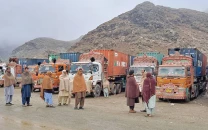CPEC and its critics
It will profoundly change the structure of the country’s economy and alter the lives of all people

PHOTO: AFP
To realise its full potential, the large CPEC programme must have the support of the entire citizenry. With highways, railways, ports, power plants and industrial estates, there will hardly be a part of Pakistan the CPEC programme will not touch. It will profoundly change the structure of the country’s economy and alter the lives of all people. There are, therefore, good reasons to explain to the citizenry what will be the consequences for them of the initiative when, in terms of implementation, it has achieved a degree of maturity.
Given the reach of the programme and the fact that it is sponsored by the country that now has the world’s second-largest economy, there is reason to believe that some of China’s rival powers are attempting to throw blocks in the way as the initiative proceeds. Some of what we have begun to hear and read in newspaper coverage uses phrases that were manufactured abroad and exported to Pakistan. One repeatedly comes across statements that the programme has been launched to colonise Pakistan; that the ultimate aim of the Chinese enterprises and thousands of their employees who have entered the country has a historical precedence, the British East India Company that came in the 18th century to trade but stayed on to rule; that through the programme, China is engaged in achieving its aim of global domination without any interest in promoting Pakistan’s progress. This kind of talk is aimed to instill fear into Pakistani hearts. We must guard against this reading of the initiative and ride over the obstacles that are being thrown in the way of the programme’s successful implementation.
Competition among Chinese companies
Given the size of the China-financed programme and its dynamic nature, it has arrived in Pakistan not fully defined and developed. Its content and scope will change as it progresses. All the governments involved in developing and implementing this vast enterprise — the governments in Islamabad and Pakistan’s provincial capitals as well as the one in Beijing — will build on the programme’s successes. They will also work to mitigate the problems as the implementation of the programme proceeds. But it should be emphasised — as the Burki Institute’s report does — the programme will bring about positive change in Pakistan. The term we have used in many places in the report is that it will be a ‘game changer’ for Pakistan. It will add possibly as much as two percentage points to the growth rate in Pakistan’s GDP. If that does occur, Pakistan’s economic growth trajectory will begin to match that travelled by China and the ‘miracle’ economies of East Asia.
CPEC will bring about greater integration of Pakistan’s backward areas with those that are more developed. We can expect considerable narrowing of the per capita income gap between the provinces of Balochistan and Khyber-Pakhtunkhwa, on the one hand, and Punjab, on the other. This will happen in part by taking the sector of agriculture towards the production of higher-value products such as fruits and vegetables. These would be processed and exported to western parts of China that don’t have the local capacity to provide for the anticipated increase in their population.
Sheer size of CPEC portfolio appals IMF
China also has a growing appetite for livestock products, a sector that has done well but remains relatively underdeveloped in Pakistan. Supplying meat, milk and milk products to western China could help this sector to grow. Since women are actively involved in this sector, its development would help increase their income and independence.
The CPEC initiative will link Pakistan with the global economic system from which it has remained relatively detached. One way this initiative could bring Pakistan’s economy closer to that of the rest of the world is by making the country’s small engineering enterprises enter the supply chains to feed into the production of final products. The global automobile industry is a good example of the way parts and components manufactured in different parts of the world get used to produce the final product. The large car and truck-manufacturing industry in the United States is heavily dependent on the parts made in Mexico. China is now on the way to becoming the world’s largest automobile manufacturer. It too could import parts made in Punjab’s ‘golden triangle’ bounded by the cities of Lahore, Gujranwala and Gujrat.
Pakistan’s latest shot at industrialisation under CPEC needs homework
These are some of more important outcomes of the CPEC initiative which we should take into account while planning for the country’s future. We should also recognise that there are foreign interests that are interested in derailing the programme. The attempts that are being made should be understood in terms of what they are. They have been launched to hurt Pakistan while attempting to keep China out of the strategic area of which Pakistan is an important part.
Published in The Express Tribune, March 19th, 2018.
Like Opinion & Editorial on Facebook, follow @ETOpEd on Twitter to receive all updates on all our daily pieces.













COMMENTS
Comments are moderated and generally will be posted if they are on-topic and not abusive.
For more information, please see our Comments FAQ